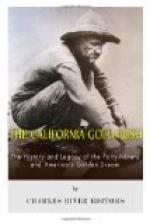The business of the day over, the evening was open for relaxation. As the hotels and lodging-houses were nothing but kennels, and very crowded kennels, it followed that the entire population gravitated to the saloons and gambling places. Some of these were established on a very extensive scale. They had not yet attained the magnificence of the Fifties, but it is extraordinary to realize that within so few months and at such a great distance from civilization, the early and enterprising managed to take on the trappings of luxury. Even thus early, plate-glass mirrors, expensive furniture, the gaudy, tremendous oil paintings peculiar to such dives, prism chandeliers, and the like, had made their appearance. Later, as will be seen, these gambling dens presented an aspect of barbaric magnificence, unique and peculiar to the time and place. In 1849, however gorgeous the trappings might have appeared to men long deprived of such things, they were of small importance compared with the games themselves. At times the bets were enormous. Soule tells us that as high as twenty thousand dollars were risked on the turn of one card. The ordinary stake, however, was not so large, from fifty cents to five dollars being about the usual amount. Even at this the gamblers were well able to pay the high rents. Quick action was the word. The tables were always crowded and bystanders many deep waited to lay their stakes. Within a year or so the gambling resorts assumed rather the nature of club-rooms, frequented by every class, many of whom had no intention of gambling. Men met to talk, read the newspapers, write letters, or perhaps take a turn at the tables. But in 1849 the fever of speculation held every man in its grip.
Again it must be noted how wide an epoch can be spanned by a month or two. The year 1849 was but three hundred and sixty-five days long, and yet in that space the community of San Francisco passed through several distinct phases. It grew visibly like the stalk of a century plant.




